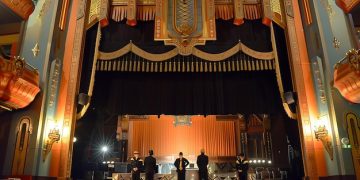Unveiling Hidden Gems: Top-Rated Lesser-Known US Theaters

Discovering the United States’ lesser-known theatrical venues with consistently high review scores reveals a vibrant tapestry of artistic excellence often overlooked by mainstream attention, yet offering unparalleled performance quality and unique cultural experiences for dedicated patrons.
In a landscape dominated by Broadway and major regional playhouses, a vibrant ecosystem of smaller, independent theaters across the United States consistently garners rave reviews. This article, Unveiling Hidden Gems: Lesser-Known Theaters Across the US with Consistently High Review Scores, delves into these often-overlooked cultural bastions, celebrating their commitment to artistic integrity, community engagement, and unforgettable performances.
The Allure of the Undiscovered Stage
Beyond the bright lights of New York’s theater district and the grand marquees of established regional companies, lies a world of smaller, often more intimate venues. These “hidden gems” are not necessarily a secret to their local communities, but they rarely receive national recognition despite consistently delivering exceptional theatrical experiences. Their charm often lies in their unique programming, their deep connection to local talent, and their ability to foster a strong sense of community among artists and audiences alike.
The consistent high review scores these theaters receive are a testament to their dedication. They often operate with smaller budgets and fewer resources, yet manage to produce work that rivals, and sometimes surpasses, that of their larger counterparts. This excellence is built on a foundation of passionate individuals – actors, directors, designers, and administrators – who pour their hearts into every production.
What Defines a “Hidden Gem” Theater?
Defining a hidden gem isn’t just about size or fame; it’s about impact and quality relative to visibility. These theaters thrive on repeat business and word-of-mouth, building loyal fan bases that appreciate their distinct artistic voices.
- Unique Artistic Vision: They often focus on new works, experimental pieces, or lesser-known classical plays that larger theaters might deem too risky.
- Community Roots: Many are deeply embedded in their local communities, offering educational programs, fostering local artists, and reflecting local narratives.
- Intimate Settings: Smaller venues often allow for a closer connection between performers and audience, enhancing the theatrical experience.
- Consistent Excellence: Despite being less known, their productions consistently earn high praise for acting, direction, design, and overall impact.
These venues represent the grassroots of American theater, proving that artistic brilliance isn’t solely confined to prominent cultural hubs. Their continued success and high audience satisfaction highlight a demand for diverse and accessible theatrical experiences nationwide.
Spotlight on Stellar Midwest Venues
The Midwest, often stereotyped as a cultural backwater, is actually home to a surprising number of exceptional, albeit lesser-known, theater companies. These venues offer a rich blend of traditional and contemporary works, contributing significantly to the cultural fabric of their cities without often making national headlines. Their commitment to artistic quality is evident in their consistently high review scores, often praising their innovative performances and strong community connections.
One notable example is the Steppenwolf Theatre Company’s LookOut Series in Chicago, which, while part of a larger, well-known institution, specifically champions emerging artists and experimental works in an intimate setting, often flying under the radar compared to Steppenwolf’s mainstage productions. This series consistently provides a platform for groundbreaking new voices, earning fervent praise from critics and audiences alike for its daring and thought-provoking shows.
Milwaukee’s Artistic Heartbeat
Milwaukee, Wisconsin, provides fertile ground for several such theaters. The Milwaukee Rep’s Stackner Cabaret, though part of a major regional theater, offers a more intimate, cabaret-style experience that consistently delights with its musical productions and engaging storytelling, standing out from its larger main stage offerings.
- Next Act Theatre: Known for its thoughtful and challenging contemporary plays, often tackling complex social issues with sensitivity and intelligence.
- Renaissance Theaterworks: Dedicated to promoting women in theater, both on and off stage, and recognized for its powerful performances and compelling narratives.
- Carte Blanche Studios: An experimental venue pushing the boundaries of traditional theater, often engaging audiences in immersive and interactive experiences.
These Milwaukee theaters, alongside others, prove that robust theatrical innovation and enduring quality are thriving outside the usual urban centers. Their consistent ability to earn high marks from audiences and critics underscores their vital role in cultivating vibrant arts scenes.

Southern Stages: Warmth and Innovation
The American South, a region rich in storytelling tradition, cultivates a diverse array of theater experiences that blend historical narratives with contemporary flair. These venues, often smaller in scale, offer productions that resonate deeply with local communities while still pushing artistic boundaries. Their commitment to quality shines through in their consistent high ratings, drawing appreciative audiences who seek both familiar comfort and innovative performances.
For instance, the Warehouse Theatre in Greenville, South Carolina, is a bastion of theatrical excellence. It consistently receives accolades for its bold programming, which ranges from classic dramatic works to provocative new plays. Their productions are frequently lauded for strong acting, imaginative staging, and a fearless approach to storytelling, creating powerful and memorable experiences for patrons who are keen to discover quality theater outside major metropolitan zones.
Texas’ Diverse Theatrical Landscape
Texas, with its vast geographical and cultural diversity, harbors several lesser-known theaters that are making significant waves. From intimate black box spaces to historic playhouses, these establishments contribute significantly to the state’s vibrant arts scene.
- Kitchen Dog Theater (Dallas): Esteemed for its commitment to new works and contemporary voices, providing a platform for playwrights and performers to explore challenging themes.
- Rude Mechanicals (Austin): Renowned for its experimental and avant-garde productions, consistently pushing the boundaries of theatrical form and engaging audiences in unique ways.
- The Alley Theatre’s Neuhaus Theatre (Houston): While part of a larger complex, this intimate space within the Alley Theatre often hosts more experimental and cutting-edge works that might not fit the mainstage, consistently earning high praise for its fresh approach.
These Southern theaters embody a resilient spirit, fostering creativity and delivering high-caliber performances, proving that compelling narratives and stellar artistic execution are not exclusive to the coasts. Their continued success, as reflected in enthusiastic reviews, speaks volumes about their impact and the dedication of their teams.
Pacific Northwest: Craftsmanship and Community
The Pacific Northwest is renowned for its independent spirit and commitment to local, sustainable practices, principles that extend profoundly into its vibrant theater scene. Here, numerous smaller theaters thrive, not through grandiosity, but through meticulous craftsmanship, compelling storytelling, and a deep sense of community engagement. These venues often become local fixtures, celebrated for their consistent artistic quality and their ability to forge meaningful connections with audiences. They are frequently lauded for their innovative approaches to both classic and contemporary works, consistently earning high review scores from a discerning public.
One prime example is the Artists Repertory Theatre in Portland, Oregon. While it has a well-established reputation locally, it often flies under the national radar compared to larger regional theaters. Artists Rep is consistently praised for its unwavering commitment to developing new plays and nurturing local talent. Their productions are known for their intimate portrayals and high artistic standards, making every visit a memorable experience and cementing its status as a vital part of Portland’s cultural landscape.
Seattle’s Intimate Stages
Seattle, a hub of innovation, also boasts a thriving ecosystem of smaller theaters that consistently deliver powerful performances. These venues contribute significantly to the city’s rich arts culture, often providing a space for experimental work and diverse voices.
- ACT – A Contemporary Theatre’s Allen Theatre: This smaller venue within the larger ACT complex focuses on innovative and often socially conscious plays, offering an intimate experience that consistently garners critical acclaim.
- Seattle Public Theater: Located in a historic landmark building, this theater is lauded for its focus on new American plays and its dedication to local artists, often featuring thought-provoking and engaging productions.
- Strawberry Theatre Workshop: A collective known for its commitment to social justice and politically charged works, earning respect for its courageous programming and powerful performances that challenge and inspire.
The theaters of the Pacific Northwest exemplify a model where quality and community are paramount. Their high review scores are not just indicators of theatrical excellence, but also reflections of their profound impact on local audiences and their unwavering dedication to the art of live performance.

The Northeast’s Diverse Theatrical Landscape Beyond Broadway
While New York City often dominates discussions of Northeastern theater, the region beyond Manhattan’s bright lights is a treasure trove of smaller, independent venues that consistently deliver exceptional theatrical experiences. These theaters are vital cultural assets, known for their innovative programming, commitment to artistic excellence, and deep community ties. They provide a refreshing alternative to the commercial pressures of Broadway, offering unique perspectives and fostering a vibrant local arts scene, all while securing consistently high review scores from devoted patrons.
Consider the Huntington Theatre Company’s Wimberly Theatre in Boston, Massachusetts. While the Huntington is a respected regional theater, its Wimberly space specifically allows for more intimate and often more experimental productions than its larger mainstage. This approach consistently earns high praise for bold artistic choices and phenomenal performances, providing unforgettable experiences that resonate deeply with audiences seeking nuanced and powerful storytelling in a more personal setting.
New England’s Artistic Enclaves
Across New England, numerous theaters are making their mark with distinctive programming and dedicated craftsmanship. These institutions often become cornerstones of their respective communities, celebrating both new works and beloved classics.
- Hartford Stage (Hartford, CT): Known for its innovative interpretations of classics and its commitment to new American plays, consistently attracting critical acclaim for its ambitious and polished productions.
- Trinity Repertory Company (Providence, RI): Celebrated for its ensemble acting and its deep engagement with the local community, offering a rich repertory of plays that challenge and entertain audiences.
- Merrimack Repertory Theatre (Lowell, MA): Focuses on contemporary American plays and often showcases new talent, earning high marks for its accessible yet challenging programming and its strong connection to the diverse community of Lowell.
These Northeastern theaters, while not always in the national spotlight, are cultural powerhouses within their regions. Their dedication to artistic integrity and their consistent ability to produce high-quality, engaging productions make them indispensable. The enthusiastic reviews they receive are a testament to their enduring value in the American theatrical landscape.
Mountain West & Southwest: Unique Visions in Vast Landscapes
The vast expanses of the Mountain West and Southwest might not immediately come to mind for a thriving theater scene, yet these regions host numerous “hidden gem” theaters that are cultivating vibrant artistic communities. Far from the coastal theatrical hubs, these venues often develop unique artistic visions, reflecting the distinct cultural landscapes and independent spirit of their locales. They consistently garner high review scores by focusing on compelling storytelling, fostering local talent, and providing deeply engaging experiences, proving that geographical isolation is no barrier to artistic excellence.
For example, the Denver Center for the Performing Arts’ Ricketson Theatre, part of a larger complex, often produces more intimate and experimental works that allow for closer audience engagement. This smaller venue regularly earns rave reviews for its innovative productions and commitment to new playwrights. It provides a crucial platform for diverse voices and compelling narratives, often focusing on works that resonate more specifically with the Rocky Mountain region, making it a beloved institution for its local patrons and those who specifically seek out thoughtful contemporary plays.
Arizona’s Desert Bloom of Drama
Arizona’s theatrical landscape, while perhaps less dense than other states, is home to several outstanding smaller theaters that contribute significantly to the state’s cultural richness. These companies are celebrated for their quality and their commitment to diverse programming.
- Arizona Theatre Company (Tucson & Phoenix): While a major regional player, its smaller, more intimate productions often allow for a compelling focus on new works and experimental pieces that consistently receive high acclaim.
- Black Theatre Troupe (Phoenix): Dedicated to telling stories and highlighting voices of the African American experience, consistently earning high praise for its powerful and authentic performances.
- Childsplay Theatre (Tempe): Primarily focused on theater for young audiences, but their productions are often sophisticated and engaging enough to captivate adults, consistently receiving accolades for their creativity and educational impact.
These theaters in the Mountain West and Southwest are testament to the enduring power of live performance to connect, inspire, and entertain. Their success, measured by overwhelmingly positive audience and critical reviews, underscores their significant contribution to the national theatrical conversation, proving that authentic artistic expression thrives in every corner of the United States.
The Impact and Future of Lesser-Known Theaters
The enduring success and consistent high review scores of lesser-known theaters across the U.S. highlight their critical role in the broader theatrical ecosystem. These venues are not just places where plays are performed; they are cultural incubators, community anchors, and vital training grounds for future generations of artists. Their commitment to artistic integrity, often unburdened by the commercial pressures of larger institutions, allows for greater experimentation and a deeper exploration of themes that resonate with specific local audiences.
The “hidden gem” status of these theaters often implies a more direct relationship between the audience and the art. Patrons frequently feel a stronger sense of ownership and personal connection to these companies, leading to a loyal base that champions their work through word-of-mouth and consistent attendance. This grassroots support is invaluable, sustaining theaters that might otherwise struggle for visibility.
Challenges and Opportunities
Despite their artistic success, these theaters face unique challenges. Funding is often leaner, dependence on grants and individual donations is higher, and marketing budgets are limited. Yet, these constraints often foster incredible creativity and resourcefulness.
- Digital Adaptations: The pandemic spurred many smaller theaters to innovate with digital streaming, expanding their reach beyond geographical limitations and potentially attracting new audiences globally.
- Community Partnerships: Collaborations with local businesses, schools, and cultural organizations strengthen their community ties and provide additional resources and visibility.
- Niche Programming: Focusing on specific genres, themes, or playwrights allows them to cultivate a dedicated audience base that actively seeks out their unique offerings, further cementing their identity.
The future of American theater is intrinsically linked to the health and vitality of these smaller, celebrated venues. They are the proving ground for new ideas, the birthplace of emerging talent, and the custodians of diverse artistic voices. As audiences increasingly seek authentic and meaningful experiences, these consistently highly-rated hidden gems are poised to gain even greater recognition, continuing to enrich the cultural tapestry of the nation.
| Key Point | Brief Description |
|---|---|
| 🎭 Unique Artistic Vision | Lesser-known theaters often feature experimental works, new plays, or unique interpretations of classics. |
| 📍 Community Centric | Many are deeply integrated into local communities, fostering local talent and reflecting regional narratives. |
| ⭐ Consistent Excellence | Despite their size, these venues consistently receive high review scores for quality productions. |
| 🌱 Artistic Incubation | They serve as vital platforms for emerging artists and experimental works. |
Frequently Asked Questions About Hidden Gem Theaters
These theaters thrive on artistic passion and a strong connection with their audiences. They often prioritize quality over commercial viability, focusing on unique programming, meticulous production values, and fostering authentic performances. This dedication, despite smaller budgets, consistently translates into powerful and memorable theatrical experiences for patrons.
While many are in major cities, they are also prevalent in smaller towns and suburban areas across the United States. Their charm often lies in being deeply embedded in their local communities, often reflecting regional narratives and providing cultural hubs that might otherwise be absent. This geographic diversity is a hallmark of their appeal.
You can expect a diverse range of productions. Many specialize in new works, experimental plays, or bold reinterpretations of classics, themes that might be considered too risky for larger, more commercial venues. Their programming often reflects a distinct artistic vision, leading to thought-provoking and unique theatrical encounters.
Local arts guides, community newspapers, and online review sites like Yelp or Google Maps are excellent resources. Often, word-of-mouth within local artistic circles is also a powerful tool. Engaging with local performing arts blogs and social media groups dedicated to theater in your area can also reveal many exciting options.
Supporting these theaters is crucial for nurturing artistic diversity, fostering local talent, and preserving the grassroots of live performance. They provide platforms for emerging artists, contribute significantly to local economies, and offer unique cultural experiences that enrich communities. Your patronage directly helps sustain these vital artistic incubators.
Conclusion
The exploration of lesser-known theaters across the United States reveals a vibrant and indispensable segment of the American performing arts landscape. These hidden gems, consistently lauded with high review scores, stand as powerful testaments to artistic bravery, community dedication, and unwavering commitment to quality. Far from the glaring spotlights of larger, more commercial venues, they cultivate intimate spaces where stories are told with profound authenticity and innovative spirit. Their continued success and critical acclaim underscore a fundamental truth: truly excellent theater knows no bounds of size or fame. By seeking out and supporting these remarkable institutions, we not only discover unforgettable performances but also contribute to the vital nurturing of artistic talent and cultural diversity that enriches the entire nation.





